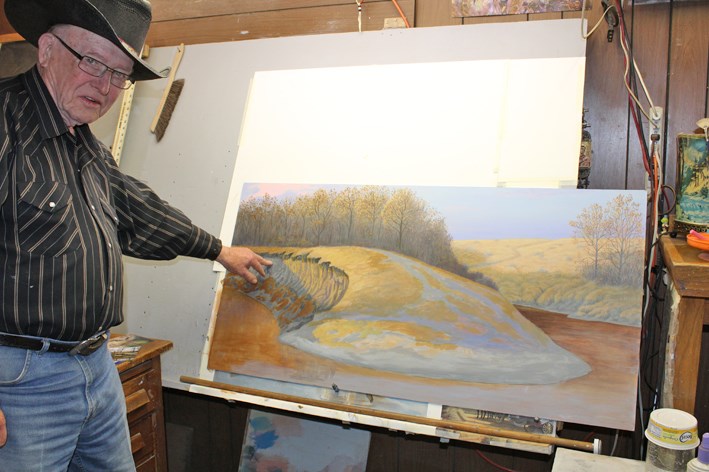Terry McLean has dug ditches, broke horses, worked in Virden’s Post Office, and operated seismic equipment for the Chevron oil company, but it is his work with brush and canvas that has made him known throughout North America as a wildlife artist.
The outdoors, it’s features and creatures, as well as the Western lifestyle comprise the bulk of his work.
In his workspace/office, McLean is surrounded by a timber wolf pelt, wild birds and water fowl. On a barn-board clad wall is a display of hats, Aboriginal artifacts, RCMP related memorabilia, antique weaponry and western tack.
Pointing to a long, wool Hudson Bay coat, he chuckles. “I rode in parades with it.”
He’s no taxidermist, but his interest lies in correctly capturing the lie of the feathers or the colour and profile of the wild animals that he depicts on canvass.
On his library shelves stand neatly rowed volumes - from world history to local accounts, fiction by James A. Michener, tales of the Old West.
McLean’s work was a regular feature on the cover of a firearm catalogue - S.I.R. and later on, Cabelas’ hunting, fishing and outdoor gear publication.
His library contains art instruction manuals and McLean did take painting lessons.
He laughs, “I came home and painted the way I always did.” He’s a self-taught artist whose creativity was bursting at the seams.
McLean did art from his earliest days and began painting in earnest in his 20s.
His life experience is a varied portfolio, some of it not so glorious. He enjoyed working for Mr. Finch, a local cattle buyer.
“As we rode around collecting cattle, we noticed how many horses were hanging around in fields, not being used anymore. This was the early ‘50s. So he started buying them and I’d break them in for him and sell them as riding horses.”
He says training has come a long way. “There’s such a better way of doing it now. Without violence… it’s great!”
Some will remember McLean in the post office in the ‘50s.
“I started at $0.94 an hour at the Post Office.”
After eight years there, McLean started work for Chevron in the ‘60s, where, for 11 years he operated a seismic oil well tester.
All this time, McLean was painting.
“I was 40 and I said to myself, ‘Are you going to be a part-time oil jockey and a part-time slopping around painter, or are you going to make the break?’ So I went in and told them I was going to quit.
“I had 41commissions to do when I quit… at $400 a piece.”
In the ‘70s he attended the first (and only) Cowboy Art show in Calgary. One of his pieces was auctioned for $1,800; one went for $2,000, another for $2,100 – a milestone for the Virden artist.
Since then, McLean has shown and sold his art throughout the USA.
“In New York I had a line-up for autographs.” He chuckles, “I thought, ‘poor devils, they think I am somebody.’”
His plates came about through the genius of promoter and friend, Ed Purvis, Chicken Chef owner at the time. When 5,000 numbered plates of Phantom of the North sold out in a year, he knew he was on to something.
“He put me into Wild Wings, the biggest print outfit (for collector plates) in the States.”
McLean grew up around the subject of much of his art. His father was a fur trapper and fur farmer.
“I’ve studied animals and birds ever since Dad had them in cages.”
His appreciation for animals is evident. He says, “I make money from animals the same as Dad did, only I don’t kill them.”
The tragic fire on Virden’s Seventh Ave. in September, 2017 took hundreds, maybe thousands of prints that were stored in the heritage building, Terry McLean Art Gallery.
Over 70 original framed pieces have had to be cleaned.
Currently, at 84, McLean has a large oil painting underway.
“This one I’ve just started on. It’s right here on the farm,” he says pointing to the serpentine river cutting steeply into a bank. A line of buffalo will be painted on the high ridge over the creek, “Because, right about here we found a buffalo skull and a lot of the skeleton, in the bank, three feet from the top.”
GIFT TO MMF
Terry and son Lance McLean travelled to Winnipeg last weekend, to attend the Manitoba Metis Federation awards ceremony where McLean presented a very special painting to the MMF.
The large, framed acrylic canvas depicts Gabriel Dumont, a key leader of the Metis people in the 1800s.
It will be displayed in the future Metis Heritage Centre in Winnipeg. Dumont was known as a fine hunter in the days of the Metis buffalo hunt. In McLean’s painting Dumont is posed with "le petit", his famous rifle, raised.




